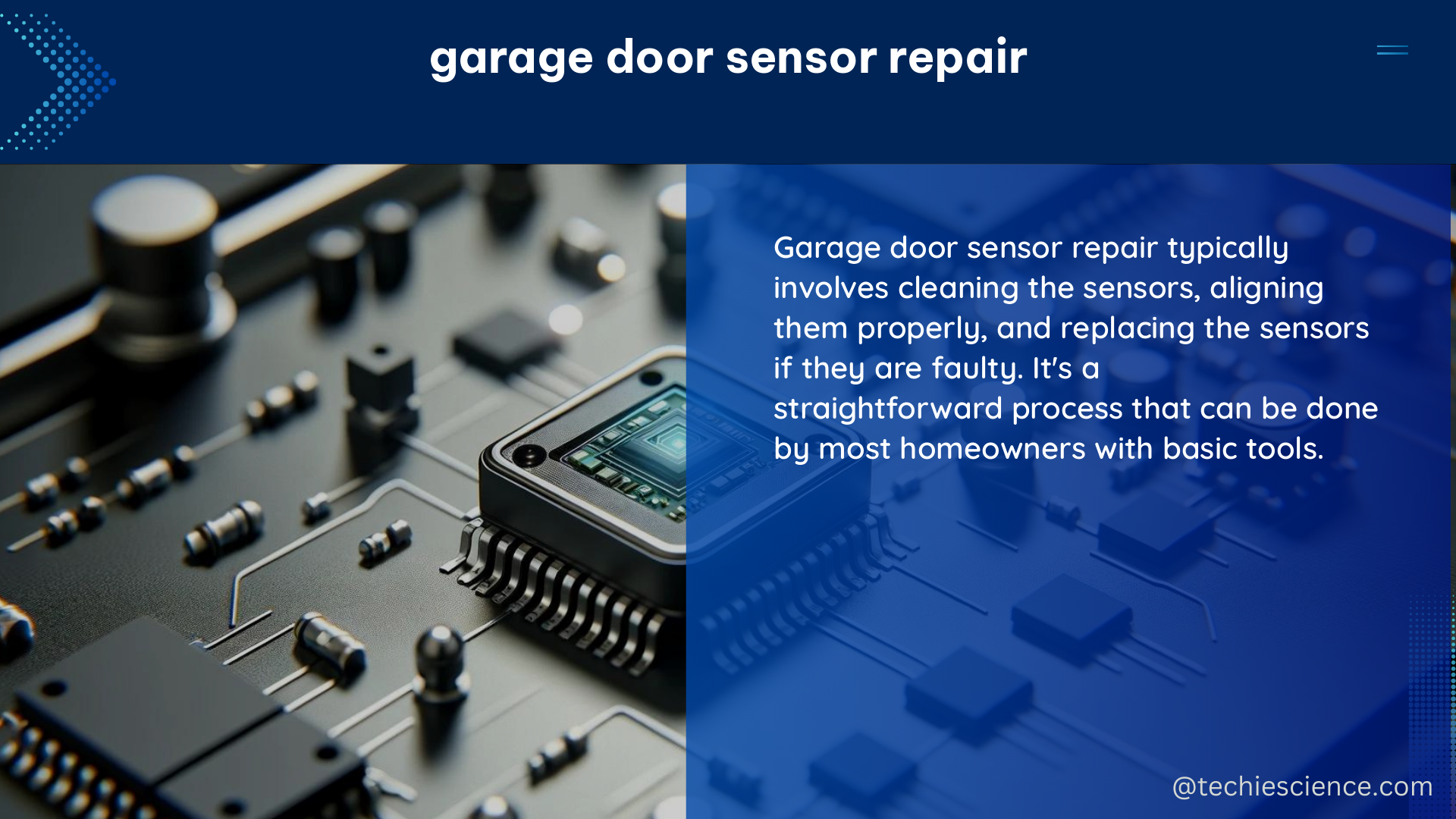Garage door sensors are essential safety components that prevent accidents and injuries by automatically reversing the door’s motion if an obstruction is detected. However, these sensors can sometimes malfunction, requiring prompt attention. This comprehensive guide will delve into the intricacies of garage door sensor repair, equipping you with the knowledge and techniques to address common issues and ensure the safe operation of your garage door.
Understanding Garage Door Sensors
Garage door sensors consist of two primary components: the sending sensor and the receiving sensor. These sensors are typically placed approximately 6 inches above the ground on either side of the garage door opening. The sending sensor emits an invisible infrared beam that is detected by the receiving sensor. If this beam is interrupted, the garage door opener is triggered to stop or reverse the door’s motion, preventing potential harm.
Common Garage Door Sensor Issues

-
Misalignment: Over time, the sensors can become misaligned, causing the infrared beam to miss the receiving sensor. This can be due to physical disturbances, such as bumping or shifting of the sensors.
-
Dirty Lenses: Dust, debris, or grime can accumulate on the sensor lenses, obstructing the infrared beam and causing the sensors to malfunction.
-
Faulty Wiring: Loose, damaged, or improperly connected wires between the sensors and the garage door opener can disrupt the communication and signal transmission, leading to sensor failure.
-
Electrical Surges: Sudden power spikes or lightning strikes can damage the electronic components within the sensors, rendering them inoperable.
-
Aging Equipment: Over time, the sensors themselves may wear out or become less reliable, particularly in older garage door opener models.
Garage Door Sensor Repair Techniques
- Sensor Alignment:
- Measure the distance between the sending and receiving sensors to ensure they are positioned approximately 6 inches above the ground and facing each other directly.
- Use a level to check the horizontal and vertical alignment of the sensors, adjusting their position as needed.
-
Tighten the mounting screws or brackets to secure the sensors in their proper alignment.
-
Lens Cleaning:
- Gently wipe the sensor lenses with a soft, lint-free cloth or a microfiber cloth to remove any accumulated dust or debris.
- If the lenses are heavily soiled, use a mild cleaning solution (such as a mixture of water and isopropyl alcohol) and a soft, non-abrasive cloth to clean them.
-
Avoid using harsh chemicals or abrasive materials, as they can damage the sensor lenses.
-
Wiring Inspection and Repair:
- Disconnect the garage door opener from the power source before inspecting the sensor wiring.
- Visually inspect the wires for any signs of damage, such as fraying, cuts, or loose connections.
- Use a multimeter to test the continuity of the wires and ensure proper connectivity between the sensors and the opener.
-
If any wires are damaged, carefully replace them, ensuring a secure and reliable connection.
-
Sensor Replacement:
- If the sensors are beyond repair or the issue persists after addressing alignment, lens cleaning, and wiring, the sensors may need to be replaced.
- Consult your garage door opener’s manufacturer to obtain compatible replacement sensors.
-
Follow the manufacturer’s instructions for properly installing and configuring the new sensors.
-
Professional Assistance:
- For complex issues or if you’re unsure about your ability to safely and effectively repair the garage door sensors, it’s recommended to hire a professional garage door technician.
- Experienced technicians have the necessary tools, expertise, and knowledge to diagnose and resolve sensor-related problems efficiently and in compliance with safety standards.
- They can also ensure that your garage door meets all UL-325 requirements, which mandate the use of photoelectric sensors or edge sensors for added safety.
Preventive Maintenance
To minimize the likelihood of future garage door sensor issues, it’s essential to perform regular maintenance:
- Visually inspect the sensors and their wiring every few months for any signs of damage or misalignment.
- Clean the sensor lenses periodically using a soft, lint-free cloth to prevent the buildup of dust and debris.
- Ensure that the sensors are securely mounted and properly aligned, adjusting their position as needed.
- Consider upgrading to newer, more reliable sensor models if your garage door opener is outdated or prone to sensor-related problems.
By following these comprehensive garage door sensor repair techniques and implementing preventive maintenance, you can ensure the safe and reliable operation of your garage door, protecting your family and property from potential accidents.
References:
- Garage Door Sensor Troubleshooting and Repair
- What Might Cause Garage Door Opener Sensors to Work Intermittently?
- Garage Door Sensor Repair

The lambdageeks.com Core SME Team is a group of experienced subject matter experts from diverse scientific and technical fields including Physics, Chemistry, Technology,Electronics & Electrical Engineering, Automotive, Mechanical Engineering. Our team collaborates to create high-quality, well-researched articles on a wide range of science and technology topics for the lambdageeks.com website.
All Our Senior SME are having more than 7 Years of experience in the respective fields . They are either Working Industry Professionals or assocaited With different Universities. Refer Our Authors Page to get to know About our Core SMEs.